Ellerby's "History of the Minerva Lodge of Freemasons No. 250 Hull, 1783 to 1933", brought to the Bi-centenary 1935 -1983 by Austin and Hopley has little more to report and the author of this website history requested that (like those prededing him) he has access to the minutes of past meetings. An email from a past Secretary (son of the bi-centenary WM) remarked on the changing styles thusly:
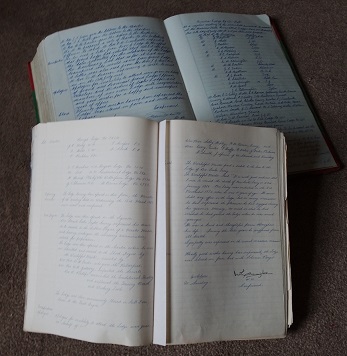 Nov 1965 - Sep 1983 - beautiful full bound ledger, leather and rexine, tub sized air dried ledger paper 24lbs demy
Nov 1965 - Sep 1983 - beautiful full bound ledger, leather and rexine, tub sized air dried ledger paper 24lbs demy 1980 had started on a chilling note, A Civil Defence booklet had been issued to every home in the UK; for an anxious public, nuclear confrontation seemed almost inevitable. Yet by the close of the decade, Mikhail Gorbachev’s vision of ‘Glasnost’, a more open society would become a reality. The 1940’s Cold War era would be at an end.
1980 had started on a chilling note, A Civil Defence booklet had been issued to every home in the UK; for an anxious public, nuclear confrontation seemed almost inevitable. Yet by the close of the decade, Mikhail Gorbachev’s vision of ‘Glasnost’, a more open society would become a reality. The 1940’s Cold War era would be at an end.
Profound changes were afoot at home, a boom in consumerism, homeownership, and shareholding. An age for the entrepreneur or ‘Yuppie’ (Young upwardly mobile professional person.) carrying their mobile phones – the size of a giant brick. Apple began to become something you spent your entire budget and existence on, not something you left on a teacher’s desk.
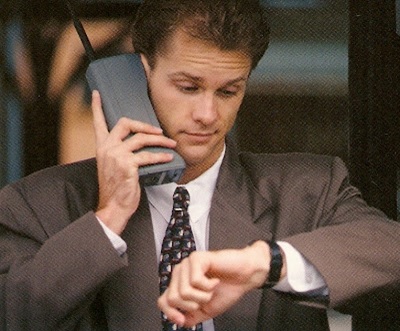 Locally, the death knell of the Humber ferries sounded after hundreds of years of service, as the Humber Bridge was opened. One of the former Humber paddle ferries, ‘Lincoln Castle’ became a restaurant, moored at Hessle Foreshore. Other vessels were berthed in the newly opened Hull Marina. 1982 saw the North Sea Ferry ‘Norland’ setting sail for the Falklands . . . and coming back.
Locally, the death knell of the Humber ferries sounded after hundreds of years of service, as the Humber Bridge was opened. One of the former Humber paddle ferries, ‘Lincoln Castle’ became a restaurant, moored at Hessle Foreshore. Other vessels were berthed in the newly opened Hull Marina. 1982 saw the North Sea Ferry ‘Norland’ setting sail for the Falklands . . . and coming back.
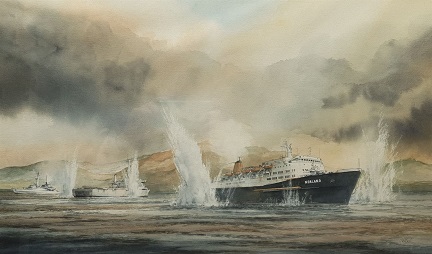 This was a time of great innovation in pop music, as bands inspired by the can-do attitude of the punks and by the art-school cool of David Bowie began to experiment with synthesisers and computers, innovativetechnologies that would change forever the way music was made. It would be heard booming out from the big floats of the Lord Mayor’s Parade as it made its way along the newly opened Freetown Way to East Park, home of the Hull Show.
This was a time of great innovation in pop music, as bands inspired by the can-do attitude of the punks and by the art-school cool of David Bowie began to experiment with synthesisers and computers, innovativetechnologies that would change forever the way music was made. It would be heard booming out from the big floats of the Lord Mayor’s Parade as it made its way along the newly opened Freetown Way to East Park, home of the Hull Show.
Parents would no longer have to suffer the current week' Top 20; carefully recorded on a Sunday night, accompanied invariably with background noises of family conversation, dinner plates being clattered and the dog barking. All captured for posterity or until the tape got chewed up in the cassette machine.
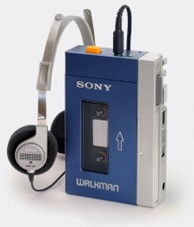
 The Sony Walkman would take the place of those heavy and bulky cassette players. For the first-time ever, music would become portable and personal via lightweight headphones, and it was small enough to clip to a belt or tuck in a pocket. You could listen to music while walking, jogging, or sat on a ‘Blue and White' Corporation bus heading to town. The perfect match for the ‘in vogue’ shell suited youngsters while they ate fish straight off the docks at the Gainsboro Restaurant, while getting their siblings to solve that annoying Rubik’s cube on the journey home.
The Sony Walkman would take the place of those heavy and bulky cassette players. For the first-time ever, music would become portable and personal via lightweight headphones, and it was small enough to clip to a belt or tuck in a pocket. You could listen to music while walking, jogging, or sat on a ‘Blue and White' Corporation bus heading to town. The perfect match for the ‘in vogue’ shell suited youngsters while they ate fish straight off the docks at the Gainsboro Restaurant, while getting their siblings to solve that annoying Rubik’s cube on the journey home.
 The global market had become intensely competitive, Japan took the lead in these new electronic and technological industries. It was the age of boom or bust, which would result in a massive impact on the personal lives of billions of people. The internet did exist in the eighties. But it was known as two highly sophisticated versions: ‘Ceefax and Teletext.’ 1989 would see Tim Berners- Lee invent the ‘World Wide Web.’
The global market had become intensely competitive, Japan took the lead in these new electronic and technological industries. It was the age of boom or bust, which would result in a massive impact on the personal lives of billions of people. The internet did exist in the eighties. But it was known as two highly sophisticated versions: ‘Ceefax and Teletext.’ 1989 would see Tim Berners- Lee invent the ‘World Wide Web.’
In Britain it was an age of decline for traditional industry and mining. Many British companies closed. Locally it heralded the end of Hull Brewery. The smell of fermenting hops would no longer waft across the city when the wind was blowing. Others became privatised, Hull City Council's telephone department being turned into Kingston Communications. (As did British Gas, British Airways, the National Bus Company, Rolls-Royce, and Council housing to name but a few. A new age on the stock market arose with some winning big, others would lose everything on ‘Black Monday’.)
 Freemasonry would experience damaging pressure, when in 1983, Stephen Knight published his book entitled; ‘The Brotherhood’. Knight was calling himself Swami Puja Debal, being a follower of the Indian spiritual leader Bhagwan Shree Rajneesh, having become a Sannyasin, whose followers do not leave society but abandon the ritual mores. Spurious claims were made, that Freemasons were responsible for the kidnapping and death of William Morgan in 1828, an American who had written an exposé on ‘Masonic secrets’; the poisoning of Mozart for his telling Masonic opera ‘Die Zauberflöte’ (The Magic Flute), and the 1888 Jack the Ripper murders, which he alleged were committed with Masonic ritual.
Freemasonry would experience damaging pressure, when in 1983, Stephen Knight published his book entitled; ‘The Brotherhood’. Knight was calling himself Swami Puja Debal, being a follower of the Indian spiritual leader Bhagwan Shree Rajneesh, having become a Sannyasin, whose followers do not leave society but abandon the ritual mores. Spurious claims were made, that Freemasons were responsible for the kidnapping and death of William Morgan in 1828, an American who had written an exposé on ‘Masonic secrets’; the poisoning of Mozart for his telling Masonic opera ‘Die Zauberflöte’ (The Magic Flute), and the 1888 Jack the Ripper murders, which he alleged were committed with Masonic ritual.
 His more concerning allegation had been one of corrupt Freemasons within the Police, exposed in the ‘Countryman’ Investigation' by London Police force. Portrayed to the reader as a great Masonic conspiracy, there was in fact nothing to indicate that Masonic membership was anything more than coincidental. However, In the wake of the book, the then Commissioner, Kenneth Newman, recommended that Metropolitan Police officers “stay away” from their Lodges, an action which was adopted by forces nationwide. The undeserved Masonic stigmatisation of the 1980’s had begun and wouldn’t be revoked until, under the headline "Enough is enough", Dr. David Staples, the then United Grand Lodge Chief Executive, had written to the Equality and Human Rights Commission about concerns that its 200,000-plus members were victims of gross misrepresentation and discrimination.
His more concerning allegation had been one of corrupt Freemasons within the Police, exposed in the ‘Countryman’ Investigation' by London Police force. Portrayed to the reader as a great Masonic conspiracy, there was in fact nothing to indicate that Masonic membership was anything more than coincidental. However, In the wake of the book, the then Commissioner, Kenneth Newman, recommended that Metropolitan Police officers “stay away” from their Lodges, an action which was adopted by forces nationwide. The undeserved Masonic stigmatisation of the 1980’s had begun and wouldn’t be revoked until, under the headline "Enough is enough", Dr. David Staples, the then United Grand Lodge Chief Executive, had written to the Equality and Human Rights Commission about concerns that its 200,000-plus members were victims of gross misrepresentation and discrimination.
By the summer of 1989, the last of the decade, the weather had been unusually warm and settled in England. For one sweet extended period that year it seemed as if everything had changed for the better. The Berlin Wall came down in November 89, it really was the end of an era. Could the 90’s be the beginning of something new and promising?
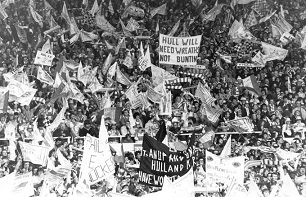 Neil is not an avid follower of sport, but the time when "Hull closed" because almost everybody went to Wembley for the Challenge Cup between Rovers and Hull FC merits mention. It was 3rd May 1980. The mass exodus of supporters from the east and west of the city, the legendary home-made sign exhorting the last to leave to turn the lights out and the thousands of fans gathering outside the Guildhall for the homecoming the following day provided an unforgettable experience for many. Hull Kingston Rovers defeated Hull 10 - 5 before a crowd of 95,000.
Neil is not an avid follower of sport, but the time when "Hull closed" because almost everybody went to Wembley for the Challenge Cup between Rovers and Hull FC merits mention. It was 3rd May 1980. The mass exodus of supporters from the east and west of the city, the legendary home-made sign exhorting the last to leave to turn the lights out and the thousands of fans gathering outside the Guildhall for the homecoming the following day provided an unforgettable experience for many. Hull Kingston Rovers defeated Hull 10 - 5 before a crowd of 95,000.
This seems an appropriate time to say a little more about W Bro Hopley, who had taken over as Lodge Secretary in 1974 and may be regarded as a model of excellencies for all aspiring to this essential Office. His cursive script is elegant and easily legible and his marginal references make it easy to find what one may be looking for; his notes in the bicentenary history are delightfully well expressed and accurate. Hopley's minutes are exquisite, and the newspaper cuttings and his own addenda show him to be so much more than an impartial recorder, but as a man who appreciates his Brethren in the Lodge and the welfare of the fraternity.
 A newspaper cutting thoughtfully inserted after the minutes of the April meeting 1980 is about "Nabs" Bannerman being awarded the MBE in the Birthday Honours List for his forty year service to the fishing industry (he developed the Torry Kiln for smoking fish.) Bro Bannerman was a member of the Minerva Lodge.
A newspaper cutting thoughtfully inserted after the minutes of the April meeting 1980 is about "Nabs" Bannerman being awarded the MBE in the Birthday Honours List for his forty year service to the fishing industry (he developed the Torry Kiln for smoking fish.) Bro Bannerman was a member of the Minerva Lodge.
In June 1980 (the installation of Arthur Barnes, which had a huge turn-out of UGLE and Provincial Officers and many visitors) there is an addendum:
"It was a source of considerable satisfaction and pleasure to the Brethren present that the north wall of the Temple, which had for some time been affected by dampness, had sufficiently dried as to enable it to be redecorated in time for this evening's intallation ceremony. This was due to the untiring efforts of W Bro Geoffrey Mell who painted all the walls of the Temple, having been assisted by Bros H W Duckwith and A W Wilson who had previously washed the walls.
"Great appreciation is also due to Bro Reginald Green for his still and effort in so expertly painting the intricate and delicate decoration of the grieze and Latin inscriptions on the affected wall . . . The newly-installed WM W Bro A L Barnes who had donated three wooden plaques engraved with the square and compasses in the three degrees, and two with MINERVA LODGE 250 -1783 to adorn the front of the bar to commemorate his installation, took the opportunity at the festive board to pay tribute to W Bro Mell and Bro Green for their efforts to enhance the Temple for the occasion of the Installation meeting."
May 1981 contains a cutting from the Hull Daily Mail which shows that plans to turn the Prince Street properties into shops and flats had given way to them being sold as private homes. "Of all the historic parts of the Old Town, it had been generally admired as the most picturesque," said Col. Rupert Alec-Smith, Lord Lieutenant of Humberside, who unveiled a plaque indicating its history. The restoration of the Georgian facade had taken longer than expected, requiring hand-made bricks and timber replacement.
Bro Neil Escreet took the Chair in 1981 and such was the necessity of ceremonies, there were extra meeting called. During his year, W Bro Escreet initiated four brethren, passed five to the Fellow Craft, and raised another four.
In October 1981 the Lodge Secretary reported that a letter from the Lodge's legal advisor at last satisfactorily concluded the provision of documents of title to the Lodge premises - an exercise which had taken six years and had involved much research. A Land Certificate of Freehold Title was now issued to the Lodge Trustees.
In June 1982, Bro Francis William Duckwith was installed as WM; again, ceremonies were worked every month.
The bicentenial year, 1983, was a time for celebration, and the election night in May followed the tradition of electing a Past Master to take the Chair for the year. W Brother Kenneth Mark Brown PPJGW (who had first taken the Chair in 1961) was elected to take the Minerva Lodge into its third century (for a list of Past Masters, please see the Past Masters Page.) Dagger Lane was full on the Bicentenary Day, 26th October 1983; the Lodge tyled at 4:30 pm but the Brethren were asked on the summons to assemble at 4.00 pm and be in their seats for 4.15 pm. Admission was by ticket only.
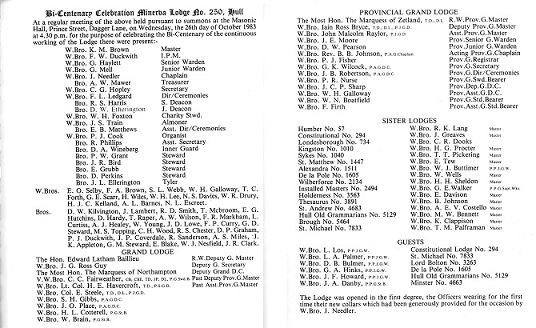
it was a huge occasion, rich in pomp and ceremony. Secretary C G Hopley was the ideal man to give a history of the Lodge.

The dinner afterwards was a seven course feast, followed by coffee, petit fours and mints, but the toasts were limited to seven. It was pleasing to discover a photograph of the bicentenary officers in the minute book. W Bro Hopley is the worried looking guy on the extreme right of the picture.

The Lodge was flourishing; extra meetings had to held to accommodate the numbers joining. Nonetheless, as Neil Armstrong noted, the general attitude towards Freemasonry was beginning to change; and the Craft to challenge the legality of Brethren being asked to declare their memberships to Local Authorities. The "penalties" in the obligations in the Craft degree were again brought into consideration, as were certain aspects of the Chapter. (The Minerva Lodge's Lecture Master, W Bro W H Foxton revised its ritual - the first use of it is recorded in January 1987.) The Methodist Church passed a resolution in July 1985 stating that membership of Freemasonry was incompatible with membership of the Church. Mention should be made here of the fire at York Minster in 1984; the restoration of the St William Window beginning a decade later forging links between Freemasonry and the Church (see next page.)
At this time, before the Internet was a universal means of communication, the TV and radio were the main media for news. Summons were sent by Royal Mail, but minutes were read out at each meeting.
W Bro Kenneth Mark Brown PJGD (WM for the bicentenary) was invested as the Assistant Provincial Grand Master on 24th April 1985. In December that year the Provincial team visited Minerva Lodge; the RWPGM, Iain Ross Bryce, the Deputy PGM John Malcolm Raylor, the APGM, along wih the Provincial DC, Standard Bearer and Sword Bearer. The Provincial Grand Master took the Chair and was saluted with seven. When retaking the Chair, the WM, W Bro D W Etherington asked the Assistant Provincial Grand Master if he would take his place for the purpose of initiating his son, Christopher McNeil Brown, and the APGM agreed. It reads in the minutes: "Mr Christopher McNeil Brown, ballotted for and accepted on the 10th April 1985, being in attendance, was admitted and regularly initiated into freemasonry by his father . . ."
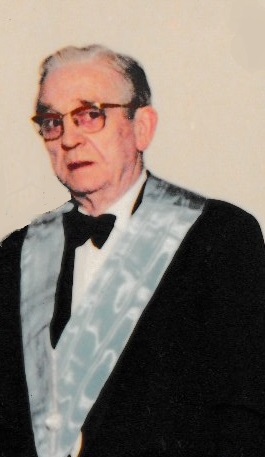 While the minutes recording the event are signed by the Secretary, they are in the handwriting of Bro Wilson, his Assistant, who has for some time been providing excellent minutes, characterised at the end with his quirky spelling of "Solumn Prayer". (Hopley always mispelled it as "Solomn".) At the Installation in 1986 (Tom McBroom) the Office of Secretary was taken over by Brother F P Curry (who spelled it correctly as "Solemn".) But this is an appropriate point to mention the tribute paid to W Bro Hopley given in Open Lodge on 9th July 1986.
While the minutes recording the event are signed by the Secretary, they are in the handwriting of Bro Wilson, his Assistant, who has for some time been providing excellent minutes, characterised at the end with his quirky spelling of "Solumn Prayer". (Hopley always mispelled it as "Solomn".) At the Installation in 1986 (Tom McBroom) the Office of Secretary was taken over by Brother F P Curry (who spelled it correctly as "Solemn".) But this is an appropriate point to mention the tribute paid to W Bro Hopley given in Open Lodge on 9th July 1986.
"Worshipful Brother Charles George Hopley, known to us all affectionately as Brother Bill," writes W Bro Frank Ledgard, who has known him for nearly fifty years and was his proposer into the Craft describes him as having "a tremendous sense of duty and loyalty, a tireless worker with tenacity of purpose, the ability to buckle into tasks that lesser men would walk away from, an orderly and disciplined mind, wisdom to comprehend and foresight to anticipate problems, a comprehensive knowledge of Ritual, a complete familiarity with th Book of Constitution . . ." W Bro Ledgard is lyrical in his praise, outlining the duties fulfilled over the last twelve years, the organisational skills and the history of the Lodge undertaken by this remarkable character. He mentioned Hopley's unremitting care and attention devoted to his wife Hilda whom he nursed at home, making her closing days as comfortable as possible, whilst still guiding his assistant Secretary in the smooth running of the Lodge Meetings and all other Lodge activities.
A presentation was made to Bro Hopley at the Festive Board in March 1987. He had been initiated on 12th October 1955 and became Worshipful Master in 1962. His work as Secretary began in 1974 and he relinquished the post in 1985. He died on 24th November 1990.
Bro Curry dutifully recorded a double Second degree ceremony on Election night, May 1989. Attendance was still high; on this evening, the Lodge Almoner, W Bro A L Barnes entered with an escort of Officers of Provincial Grand Lodge in recognition of his having been invested with the rank of Past Provincial Grand Sword Bearer at the meeting of Provincial Grand Lodge four days earlier. Bro C H Wood was elected to take the Lodge into the next decade.
--ooOoo--

